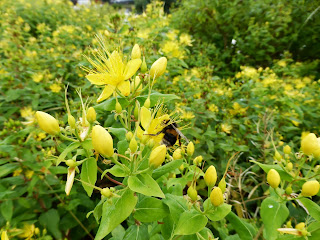We are currently moored up just beside Hampton Court Place on the River Thames and just 100m from our boat today I spied all these delights ...
Purple Loosestrife ... so pretty !
Purple Loosestrife ... so pretty !
 |
| Purple loosestrife |
 |
| Purple loosestrife |
Lovely Mugwort ... I will pick some another day and write more about it ...
 |
| Mugwort |
Apples !
 |
| Apple tree! |
 |
| Apples ... out of reach! |
 | ||
BURDOCK
... and then the highlight of my walk ... loads and loads of St John's Wort ... |
 |
| ST JOHN'S WORT AND BEES - LOADS OF THEM! |

As there was soooo much of it, I picked some St John's Wort flower heads and also a few stems to put in a little vase! I am sure the bees didn't mind me sharing it with them - they really do have so much to play with !
When I get some more I will make an infused oil with the flower heads (which will turn a wonderful red colour) but until then I just picked a few so that I could make up a flower essence. Flower essences are easy to make - you can read more about St John's Wort and flower essences on this website (click here). Basically flower essences contain the essence or the energy of the plant (as in homoeopathy) ... you will not find any physical constituents in the essence as the energy cannot be measured ... just felt ! Flower essences - as in Bach flower essences - are great for use with emotional issues.
St John's Wort's botanical name is Hypericum perforatum --- a really well known herb for treating depression but it is really so much more! The herb and oil can be used for different purposes (I use the oil in Dorn spinal therapy ... but that is a whole other story!). For the purposes of using the flower essence it can help allergies, stress, nightmares, bedwetting, sensitivity to light, seasonal affective disorder and can also be used for 'protection' - as in psychic protection - as Hypericum is great to help overly sensitive individuals who may be open to psychic attack.
I found this great website which gives a lot of info about this essence - saves me re-inventing the wheel!!!
To make the essence you fill a glass bowl with about a cupful of spring water, then cover the surface of the water with flowers. (Note ... While I was picking the flowers I was giving thanks to the plant ... you should always be in a good frame of mind when picking flowers, especially for energetic work). The flowers are then left there for an hour or two (I left mine surrounded by a crystal grid also, to add an extra 'charge'). When your time is up, the water will still look clear but the flowers will be wilted. Lift the flowers carefully out of the water with a fork - thanking them as you go - then pour the water into a clean bottle that is half full of brandy. This is then called your 'mother essence'. If there is any water left over ... just drink it!
To use the essence put three drops of the mother essence into a 25mL dropper bottle filled with brandy. This is then termed your 'stock bottle'. With this you can include it in any creams / salves / lotions / oils / soaps you may make, for added benefit (just add a few drops from your stock bottle) - or just add it directly to the skin, where needed. You can also add 20 drops to a bath or footbath - and then soak your stresses away.
To take it internally you can just add a few drops into a glass or bottle of water and sip during the day or make a 'dosage bottle' ... by putting three drops of the stock essence into a dropper bottle containing a 50/50 mix of brandy and water. Use several drops dirctly under the tongue as needed, or at least twice a day.
So easy and so useful! I am so happy and so blessed to have found this herb today on my walk ... wonder what tomorrow till bring !!











